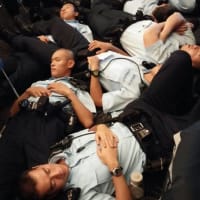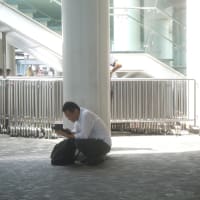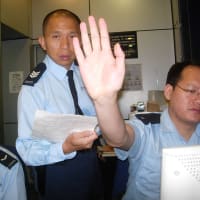怒!
中国と陸続きの場所には絶対に行かねえぞ!
あんな国地獄の劫火に焼かれて滅びてしまえ。
そもそもですね。香港紙が騒ぎ出したのが発生から2か月ほど経った2月10~11日。既に広東省では死人が出て市民がパニックに陥っていたのを10日の速報、11日12日付け紙面一面トップで報道:
空氣可傳染奪命肺炎大爆發 香港廣州掀搶購藥物潮
(蘋果日報 2003.02.11 ヘッドライン)

粤肺炎恐慌南延 市民爭買殺菌劑 港白醋搶購一空
(太陽報 2003.02.11 ヘッドライン)
http://the-sun.com.hk/channels/news/20030211/20030211024501_0001.html
廣東爆奪命炭疽疑雲 死者肺部發潰爛 病徴[月勿/口]合
(明報 2003.02.11 ヘッドライン)
粤不能忽視傳染病恐慌
(明報 2003.02.11 社説)
奪命肺炎恐慌襲港
(東方日報 2003.02.11 ヘッドライン)
肺炎恐慌顯中港通報不足
(星島日報 2003.02.11 社説)
Panic grips Guangdong as mystery pneumonia-like virus kills 6
(South China Morning Post 2003.02.11 ヘッドライン)
http://www.ziyu.net/~rent/tree/wforum.cgi?id=zombie&no=5007&reno=no&oya=5007&mode=msg_view&page=0
肺炎恐慌 北上兩港人送院 廣州派定心丸 中巴大戰照[足易]
(蘋果日報 2003.02.12 ヘッドライン)

3港人疑内地染奪命肺炎 粤證實305宗個案5人死
(明報 2003.02.12 ヘッドライン)
Guangdong must face panic
(明報 2003.02.12 社説)
[才羅]命肺炎殺到香港 七人中招
(東方日報 2003.02.12 ヘッドライン)
兩港人疑染奪命肺炎
(星島日報 2003.02.12 ヘッドライン)
http://www.singtao.com/frame.html?forcepage=/yesterday/loc/0212ao01.html
奪命肺炎南侵 港翁疑中招 逾三百人感染八死 病毒襲至深[土川]
(太陽報 2003.02.12 ヘッドライン)
http://the-sun.com.hk/channels/news/20030212/20030212024616_0001.html
Officials act as fears over virus outbreak spread
(South China Morning Post 2003.02.12 ヘッドライン)
Officials need to stay on top of rumour mill
http://www.ziyu.net/~rent/tree/wforum.cgi?id=zombie&no=5008&reno=5007&oya=5007&mode=msg_view&page=0
(South China Morning Post 2003.02.12 社説)
更に、春節で大陸に帰省した一家が感染(2名死亡)したので大騒ぎに。
9歳男児H5N1に感染 父親と妹は原因不明の感染症で死亡
(香港のほほん島 2003.02.19)
http://bbs1.kze.ne.jp/zombie/cgi/contents.cgi?fi=924&id=0
但しこの親子の場合トリのインフルエンザとして知られるH5N1が検出されたため、華南地域で流行していた原因不明の「非典型肺炎」との関連性は不明。しかし、その時。
廣東省部分地區出現非典型肺炎 專家指出只要預防得當不必恐慌
(人民日報 2003.02.12 第二版 國内要聞)
http://www.peopledaily.com.cn/GB/paper464/8441/792852.html
http://www.peopledaily.com.cn/BIG5/paper464/8441/792852.html
人民日報自ら「パニックの必要はなし」と強硬に情報封鎖を開始。大体ですね。当時大騒ぎしてたので広州の日本人学校も閉鎖になったそうである。そのため当時、日本でも一部では報道されていたぐらいであった。しかししかし、そこで更には!
Cause of pneumonia outbreak discovered
(China Daily 2003.02.20 Home News)
http://www1.chinadaily.com.cn/cndy/2003-02-20/105192.html
Disclosure of info cure for panic/Yan Xizao
(China Daily 2003.02.20 Opinion)
http://www1.chinadaily.com.cn/cndy/2003-02-20/105211.html
同じく中共機関紙&旗艦紙の英字新聞『チャイナデイリー』では「肺炎流行の原因はクラミジアであった事が判明」とする記事を掲載、「だから~大丈夫なのよ~心配ないのよ~」とあくまでシラを切る。
何が大丈夫やねん!
そもそもアノ辺、クラミジア変種の蔓延もかねてから問題となっているので、ソレも関係あるのかも知れんが、この期に及んで大陸の役人は発生源が自分の所であるのを一切認めようとせず拒否、挙句の果てに深セン市長は「香港への観光自粛を市民に呼びかけた方がいいかも~」等と言い出す始末。
お・前・ん・と・っ・か・ら
来・た・ん・だ・よ!
この糞ドタワケ!
...はぁはぁはぁはぁはぁ。わたくしも何だか熱が出てきたような気がして一昨日Taigu-ML氏に遺言を残してたりします(笑)
で、本日17日付け『New York Times』によるとWHOが世界規模で警告を発令&調査員を北京に派遣し、昨日ようやく中国政府が(ごく一部の)情報を提供し始めた、との事でございます(怒)




















China Provides Information on Deadly Health Threat
(New York Times 2003.03.17 Health)
http://www.nytimes.com/2003/03/17/health/17INFE.html
http://www.nytimes.com/2003/03/17/health/17INFE.html?pagewanted=2
*要登録
By LAWRENCE K. ALTMAN
Chinese health officials yesterday gave the World Health Organization the first, sketchy details about a mysterious respiratory ailment that is believed to have first broken out in Guangdong province last November and that Chinese officials say has tapered off in recent weeks.
W.H.O. officials were elated to receive the information, because it was the first official communication from China about the outbreak and because it provides a longer-term view of how the illness has behaved since the first cases were detected. Although the new information hints that the outbreak may be ending in Guangdong for unknown reasons, W.H.O. officials say they need more information to be certain.
"If it has burned out, it certainly will give us optimism over its control" elsewhere, Dr. David L. Heymann, executive director in charge of communicable diseases for the W.H.O., said in an interview. "That is why we need more information to know what the natural history of the illness has been since November."
The W.H.O., an agency of the United Nations, on Saturday declared the ailment "a worldwide health threat." The agency calls the ailment severe acute respiratory syndrome, or SARS, and says it has caused at least nine deaths in Canada and five other countries in recent weeks. The spread of the ailment, a form of atypical pneumonia, has been aided by international air travel. New cases, including many hospital workers, are being reported daily in affected countries, according to the W.H.O.
Laboratories in at least five countries have failed to identify any known infectious agent as a cause of the illness. The illness starts with the sudden onset of fever of 101.4 degrees or higher, muscle aches, headache, sore throat, dry cough and shortness of breath. X-rays show pneumonia or respiratory distress syndrome. Laboratory tests show low numbers of white blood cells and platelets, which help blood clot.
There have been no reports of the illness in the United States. But a 32-year-old doctor from Singapore and his 62-year-old mother-in-law are being treated for pneumonia in isolation in a German hospital after having attended a medical conference at the Crowne Plaza Hotel in New York City. Officials believe he may have contracted the illness in treating the first two cases in Singapore, where there are now 20 reported cases.
The doctor has a fever and a slight cough, and his mother-in-law has a high fever, doctors at the Johann Wolfgang Goethe-University Hospital in Frankfurt said at a news conference yesterday. They said that the doctor's 30-year-old wife, who is pregnant, has shown no symptoms.
New York City health officials said it was highly unlikely that the doctor or his family had given the illness to anyone in the city.
When asked about the issue at a St. Patrick's Day parade yesterday, Mayor Michael R. Bloomberg said he had spoken with the health commissioner, Thomas R. Frieden, and said, "Let me stress that the commissioner is reasonably confident that this guy did not infect anybody" in New York.
Health officials say they believe it takes direct and sustained contact to transmit the illness. But health officials have asked doctors to be alert to patients with flu-like symptoms who have recently traveled to Asia.
Coincidentally, infectious diseases were the subject of the meeting that the Singapore doctor attended, and news of the respiratory ailment was a hot topic in the hallways. The doctor attended the conference for two hours, said Dr. Marcelle Layton, New York City's assistant health commissioner for communicable diseases.
Dr. Layton said the Singapore doctor reported that he did not sit near other participants in the meeting and that he had minimal contact with anyone else during his stay in New York City. Dr. Layton said she had interviewed the doctor by telephone from his hospital room in Germany.
"He was very cooperative and helpful," Dr. Layton said in an interview.
Dr. Frieden "is reasonably confident that this guy did not infect anybody," Mr. Bloomberg said.
The doctor, whose name has not been released, had treated Singapore's first two cases of the illness. One patient was a doctor who had traveled to Singapore from Hanoi, Vietnam, where the outbreak has affected 46 people.
Before the Singapore doctor left home for the United States on March 11, he developed a fever, severe muscle aches and a rash, which disappeared within two to three days.
Dr. Barry M. Rosenthal, a physician at Lenox Hill Hospital in New York City, said in an interview that late Thursday night he had received a call from the Singapore doctor, who said he had a rash and fever and wanted to know where he could get a blood test because he suspected he had dengue fever, a mosquito-borne viral infection.
Dr. Rosenthal referred the doctor to another physician. New York City health officials said that X-rays showed pneumonia in one lobe of the doctor's left lung and that he was treated with oral antibiotics.
The Singapore doctor called a colleague in Singapore before leaving for home via Frankfurt. The colleague notified W.H.O. officials, who arranged to have the doctor hospitalized in Germany. Yesterday, hospital officials said his condition had worsened slightly but that he was awake, alert and asking to read newspapers.
Information about the cases was distributed to participants at the New York City conference, which ended yesterday. More information would have been given to the public if the risk of transmission had been considered greater, Dr. Layton said.
The ailment has affected hundreds of patients in China, Hong Kong, the Philippines, Singapore, Thailand and Vietnam, according to the W.H.O. In Canada, where two patients have died, there are eight other suspected cases.
The organization had previously listed Indonesia, but the cases seen there do not meet the working definition of the illness, Dr. Heymann said. Australian officials said they were monitoring a number of cases that did not meet the definition.
According to information gathered by the Chinese government over recent months but released to the W.H.O. only yesterday, SARS has behaved differently from past outbreaks of influenza, which can cause atypical pneumonia, or nonbacterial pneumonia. Chinese scientists at first thought the cases might be avian influenza but could find no evidence of any influenza virus. The current outbreak, in Guangzhou, the capital of Guangdong province, involves clusters of cases, particularly among hospital workers and family members of patients.
Chinese officials reported earlier that there were 305 cases, including five deaths. The cases have involved men and women in all age groups, but most have occurred among young adults.
The outbreak began in November and was at its peak Feb. 3 to Feb. 14. "The number of new cases decreased markedly after Feb. 15, and no new cases were detected in other cities," the Chinese reported.
In Guangdong, the fever was of long duration, but officials did not say for how long. Most patients experience a dry cough, and any sputum is often tinged with blood.
Chest X-rays of many patients showed pneumonia in both lungs. In many patients, the disease progressed rapidly, even if the fever dropped. Some experienced a secondary pneumonia caused by bacteria.
Seven percent of patients experienced such severe difficulty in breathing that tubes had to be inserted in their windpipes and presumably connected to a ventilator.
The X-rays of many patients resembled the pattern of pneumonia produced by a microbe, Pneumocystis carinii pneumoniae, or PCP, that is common in patients with AIDS but rarely seen in people with normal immune systems.
A point of confusion was a statement by the Chinese that some seriously ill patients showed "immune system functions at a low level." There was no mention of whether such patients were infected with H.I.V., the AIDS virus. Dr. Heymann said the W.H.O. was seeking a clarification.
The Chinese report also said that "most of the patients could be cured after treatment, especially the patients who have no bacterial co-infection." The report gave few details of such a cure but said that "antibiotics did not have an obvious effect."
The Chinese provided no numbers, and Dr. Heymann said that W.H.O. was asking for clarification of those statements.
Electron microscopy showed evidence of infection in four patients with one of two microbes, Chlamydia psittaci, or parrot fever, and para-chlamydia. The W.H.O. said chlamydia had not been identified in cases outside of Guangdong.
The Chinese also said that "generally, transmission became weaker and weaker," a hint that if the cause is an infectious agent, it becomes less virulent as it is passed along.
W.H.O. officials have said that they expect to be able to send experts to Guangdong soon to clarify all the points of confusion and that they expect that their work will solve the riddle of the illness.
しかしメディアは依然として口をつぐんだまま(怒)
Outbreak Originated in China
---Illness Peaked a Month Ago, Agency Told; Official Media Silent
(Washington Post 2003.03.17 Page A01)
http://www.washingtonpost.com/wp-dyn/articles/A35460-2003Mar16.html
By John Pomfret and Peter S. Goodman
Washington Post Foreign Service
Monday, March 17, 2003; Page A01
BEIJING, March 16 -- The deadly pneumonia-like illness that was the subject of a World Health Organization warning on Saturday originated in southern China in November and peaked a month ago, according to a report the Chinese government provided to WHO officials.
The outbreak sparked months of panic buying of vinegar, herbal remedies and antibiotics in China. Epidemiologists suspect it is the same illness seen over the past two weeks in Hong Kong, Vietnam, Canada, Germany, Thailand, Taiwan, the Philippines, Singapore and Indonesia.
But while news media in other parts of the world reported WHO's warning, China's media were silent on the issue today. None of the major Internet sites -- run by the official New China News Agency, China News Service and Sina.com -- contained news of the warning. Chinese journalists said they had been told not to publish the warning until the end of the annual session of China's legislature.
The illness, which originated in Guangdong province, sickened about 300 people in China, with five dying. In the subsequent wave in other countries, about 200 people have become ill, including 43 new cases reported Saturday in Vietnam. There have been fewer than 10 deaths in the second wave, although many people are still critically ill.
No cases have been identified in the United States, health officials said. But a Singaporean doctor believed to be infected was taken off a New York-to-Singapore flight in Germany on Saturday and quarantined.
The illness has killed two family members in a suburb of Toronto, and four other members of the same family are in hospital isolation today. Two other people are being treated in Toronto, one of whom had "close contact" with the infected family and one who may have contracted the illness while traveling. In British Columbia, two people were confirmed to have been infected.
The cause of the illness is unknown and is the object of an intense international search.
From the start of the outbreak, China's state-run media have veered from silence to in-depth reports to silence, providing a case study in how the government tries to manage information on sensitive topics. Reporting on the issue was banned in the early days of the outbreak, journalists said. It was suddenly permitted for a week in February. Then, apparently, it was banned or severely limited again, Chinese media sources said.
Despite China's report to the World Health Organization, officials have been reluctant to publicly link the outbreak in Guangdong province to illness. In the only recent statement on the disease by a senior Chinese official, Zhu Qingsheng, the deputy health minister, told Wen Wei Po, a pro-Beijing Hong Kong daily, on Friday that "no clue indicates that the virus originated in Guangdong Province."
Guangdong's top official, Zhang Dejiang, called on the local health authorities to set up an emergency task force. In a sign of the prevailing fear and confusion, he ruled out one possible cause of the outbreak suggested by Hong Kong media. "This is not caused by anthrax," he said. "Experts are still investigating the cause."
The report sent to the World Health Organization by the Chinese Health Ministry said the "peak of the disease outbreak was during 3-14 February," and that the number of new cases has since "decreased markedly." However, the Wen Wei Po newspaper reported over the weekend that the number of cases in Guangdong province was increasing.
The panic buying soon embroiled Roche Group, the Swiss pharmaceutical giant.
On Feb. 9, Roche representatives held a news conference in Guangzhou at which they discussed the outbreak of the disease and handed out fact sheets about one of their antiviral medicines, Tamiflu, as a possible treatment. In the days that followed, someone posted messages in Chinese-language chat rooms asserting that "the only effective antibiotic" for the virus was Tamiflu.
The medicine soon sold out in Guangzhou, according to reports in the Chinese press, but Roche quickly shipped in more from its factory in Shanghai.
Guangdong law enforcement authorities launched an investigation and warned that Roche would be "seriously punished if it was found to have spread rumors that Guangdong was in the grips of a pneumonia and bird flu outbreak." Roche has denied any role in the Internet and mobile phone text messages. It said that sales of Tamiflu had been strong in Guangdong even before the media event there.
No bacterial or viral cause of the illness has been found during routine testing. More elaborate studies, capable of identifying exotic pathogens, have just begun.
In the United States, the Centers for Disease Control and Prevention is testing specimens from three cases -- the first victim of the most recent outbreak, a Chinese American man who fell ill in Hanoi on Feb. 26 and died in Hong Kong in early March, another Hanoi patient who is still alive, and a 44-year-old Toronto man who was apparently infected by his mother after she returned from a visit to Hong Kong. (She died also.)
A half-dozen other laboratories in Europe and Asia are also studying material from patients.
Blood will be tested for antibodies to dozens of organisms and will be "probed" for evidence of microbial genes. Researchers will also try to grow organisms, and will examine tissue with an electron microscope to see if any are visible.
"We are keeping a very open mind. As far as I am concerned, nothing has been ruled out completely," said James M. Hughes, director of the National Center for Infectious Diseases at the Centers for Disease Control.
Initial impressions suggest a virus is the cause. Some patients have low white blood cell counts and low platelet counts -- problems more commonly seen in viral than bacterial infections. The fact that victims don't appear to benefit from antibiotics also suggests that a bacterium is not at fault.
Influenza would normally be the leading candidate for the cause of an outbreak like this one.
China has large numbers of people, pigs and ducks living in close quarters, and influenza virus infects all three. In recent decades, China has been the place where new strains of the virus have emerged. However, WHO officials said yesterday that tests for influenza A -- the more virulent of the two forms of the influenza virus -- have all been negative. The Chinese Health Ministry reported the Guangdong patients showed no evidence of the "bird flu" strain of influenza A that killed a few people and many chickens in 1997.
A few patients hospitalized in Hong Kong in the recent wave of cases have antibodies in their blood suggesting recent infection with influenza B, the milder form of the virus. Such a finding is common in winter, however, and the investigators doubt it is the explanation.
There is a long list of other candidates, with a family of microbes called the paramyxoviruses "certainly ranking on the top of most people's thoughts," said Klaus Stohr, a WHO virologist and epidemiologist who is helping to direct the investigation.
David Heymann, head of communicable diseases for WHO, said that officials in Vietnam reported Saturday that most of the patients there were improving, and some had been moved out of intensive care. Previously, their condition was deteriorating.
"This is a real nasty infection. But it looks like some are able to fight it off," Heymann said. "It is a relief."
Staff writers David Brown and Rob Stein in Washington and correspondent DeNeen L. Brown in Toronto contributed to this report.
いやいや大変なことになってますね。
他人事ではありません。
南Y島は大丈夫なんでしょうか?
何人かの患者が出た九龍の滞在ホテルって?
> 何人かの患者が出た九龍の滞在ホテルって?
↑のニュースに出ていました。
せっかく香港旅行人気も復活したのに、ゴールデンウィーク
はハズレでしょうね。
>> 何人かの患者が出た九龍の滞在ホテルって?
昨日、日本のニュース見てて「アレ?」と思ったんですが、
ホテル名、全く出てないですね。つうか、台湾はさすがに
中文ニュースは香港の報道見て出す事も多いので出てます
が、他では一切出てないかも知れません。香港よりも親切
ですね(苦笑) 出るなり速報で名前バーーっと出ました。
ワタシも中文名見て即座に「香港街道地方指南」で英語名
調べました(オイ)
ホテルも可哀相ですね。広州から来た感染者の医学教授が
9階に2晩泊まったのが感染源らしいんですが、それだけ。
他の感染者も、別に一緒の部屋でも何でもない他の客です。
ホテルの客同士なんて、そんなお互い顔合わせるワケでも
ないのに、スゴイ感染力ですよね。スゴイと言えば病院で
患者診た医療スタッフが集団感染したぐらいだから、無理
もないのだが。
しかし...少なくとも香港人なら、広東省で大ブレーク
もとい大流行してたの、既に1か月前に知ってたんだから、
もーちょっと何とかならんかったもんかと思います。油断
し過ぎましたね。うううう...大体だな。中国人の人数
多すぎんだよ!(怒) アノ国の災いは皆、
1 広すぎる
2 人が多すぎる
コレが原因なのではないか。汚職も砂漠化も。貧富格差も。
なのに、コノ上まだ領土拡大する気でいるのか!(激怒)
(ゾンビさん政治の話に持ってかないでください)
で、大陸では今は収まってんでしょうか。ソレが知りたい。
世界各地でも2月ぐらいに中国行った人からジワジワ感染
者が出ています。
> せっかく香港旅行人気も復活したのに、ゴールデンウィーク
> はハズレでしょうね。
香港人も(ワタシも)当分ヨソに行けましぇーん(^^;)
(怒りの余り声も出ない)
中國首先發現非典型肺炎
(明報 2003.03.22 16:40HKT)
http://www.mpinews.com/content.cfm?newsid=200303221640gb61640a
衛生部長張文康表示,中國首先發現及報告非典型肺型,但由於難以分辨非典型肺炎,所以未有詳細數字。
張文康會見記者時,被問及香港非典型肺炎的源頭是否中國,他表示,中國首先發現及報告非典型肺型,但在個案中,有病人到過中國及香港,亦有只到過香港或中國,亦有兩地均沒有到過,有些亦去過上海,但上海至今沒發現一列非典型肺炎。
張文康表示,由於非典型肺炎不是國家規定要申報的傳染病,所以具體數字很難統計。別外,廣東爆發非典型肺炎時,他們沒有心理準備,所以統計數字不詳細。張文康強調,現時世衛專家正在北京研究非典型肺炎的源頭,暫時不會公布有關數字。